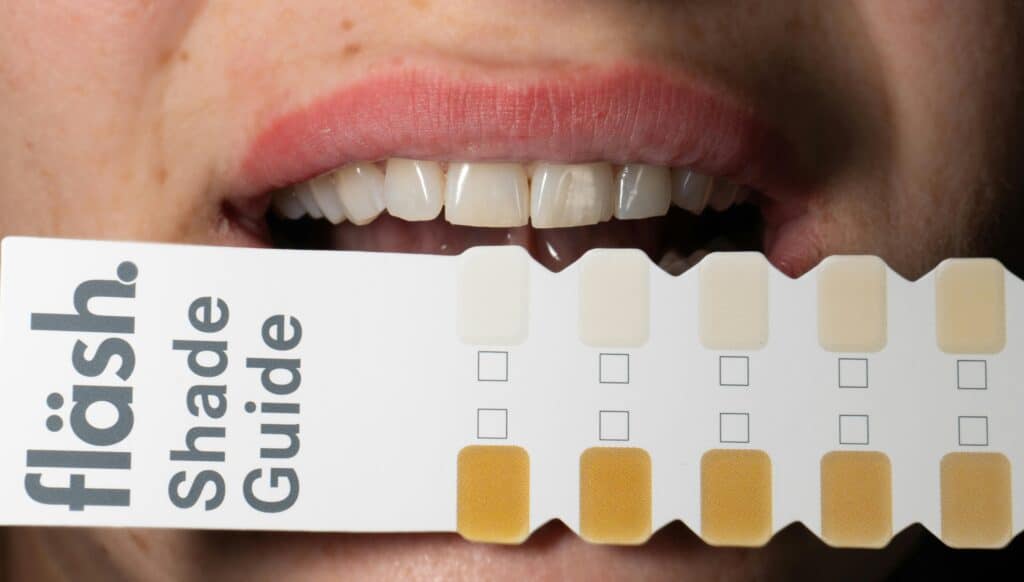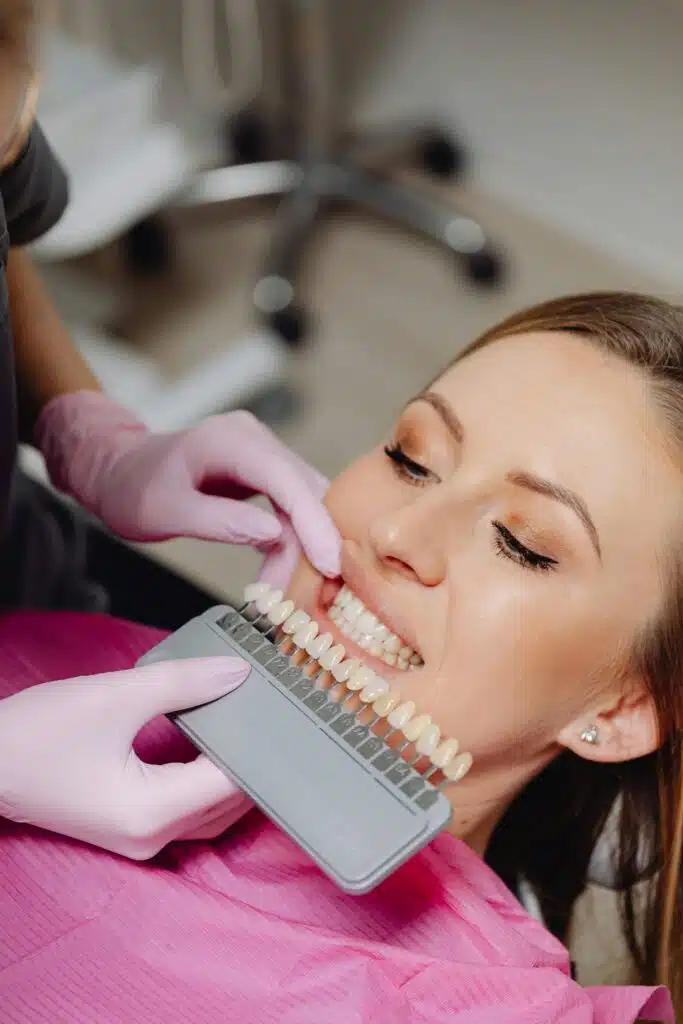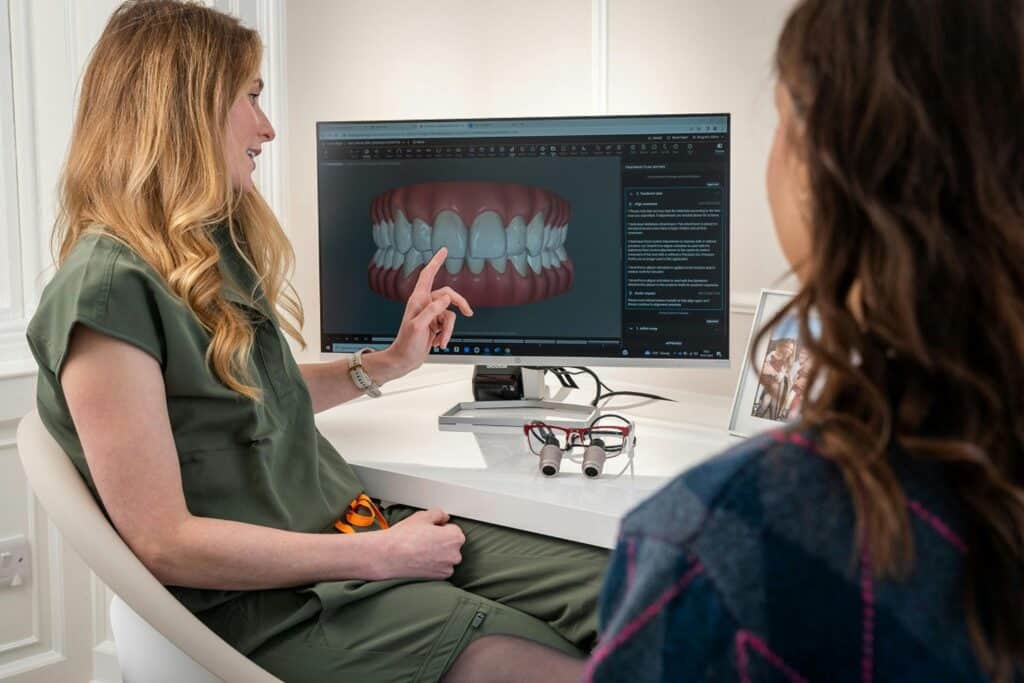Teeth aren’t T-shirts; you can’t just “bleach and go” without a plan. Done correctly, whitening is safe and effective for teens. Done wrong, it can cause real sensitivity, “white spots,” or enamel wear.
Here you’ll understand when whitening is appropriate, which methods are safest, what to avoid, and how to keep results bright.
But is it dangerous? Will the extra row straighten out on its own? And when should you call a dentist?
Is Teeth Whitening Safe for Teens?
Yes—when supervised by a dentist and timed properly. The outer enamel layer protects the inner, more sensitive dentin. Professional oversight ensures the right concentration, contact time, and tray fit, so gel brightens stains without irritating gums or harming enamel.
IMPORTANT: If your teen is asking about whitening, start with a checkup to confirm that no cavities, gum inflammation, or active orthodontic issues are present. When the mouth is healthy, you’ll have brighter results and fewer side effects. Routine checkups and cleanings are the best first step.

How to Know If Your Teen Is Ready
Use this quick readiness checklist:
- Most permanent teeth are in (usually early–mid teens).
- No braces on the teeth you want to whiten. Whitening with brackets in place leads to uneven color. If your teen is using clear aligners, ask the dentist whether the aligner trays can double as custom whitening trays during safe windows of treatment. For alignment questions, see orthodontics and clear aligners.
- No untreated decay or gum inflammation. Address health first; whiten second via preventative care.
- Realistic expectations. Whitening lifts extrinsic stains (foods, drinks) and some intrinsic discoloration, but not every tooth changes the same amount.

Whitening Options for Teens (Safest to Most DIY)
1) In-Office Whitening
Fast, supervised, and precise. Stronger gels are applied with cheek retractors and gum protection for comfort and control. If your teen wants a quick boost before photos, this is the most predictable path. Learn about professional teeth whitening options available locally.
2) Dentist-Supervised Take-Home Trays
Custom trays + precisely dosed gel. Teens wear trays for the time recommended by the dentist. Custom fit matters: it keeps gel on enamel and off the gums, and it uses less product more effectively. This can be combined with touch-ups before big events. Many offices include it within broader general & cosmetic dentistry care plans.
3) Over-the-Counter Strips and Pens
They work—but slower, less precisely, and often with more gum irritation if directions aren’t followed. Uneven coverage is common when teeth are rotated or not perfectly aligned.
Pro tip: Even if you choose OTC, ask your dentist for timing and sensitivity tips during a preventative visit.
When to Wait (or Not Whiten Yet)
VERY IMPORTANT: Hit pause and talk to a dentist if any of these are true:
- Braces are still on. Whitening now = mismatched color when brackets come off. Ask about sequencing with clear aligners if alignment is still in progress.
- Active cavities or white-spot lesions. Whitening can highlight them. Treat disease first via preventative care; then brighten.
- Significant sensitivity already. Your dentist may recommend desensitizing toothpaste, fluoride varnish, or shorter wear times before starting.
- Mixed restorations (bonding, fillings) on front teeth. Composite doesn’t whiten. You may whiten first, then replace visible composites to match—often coordinated within cosmetic dentistry.

Sensitivity: What’s Normal vs. Not
Mild, temporary “zings” during or after whitening are common, especially on the first 1–2 sessions. Try these:
- Brush with a sensitivity toothpaste for 2 weeks before starting.
- Shorten session time or skip a day between sessions.
- Ask your dentist about fluoride varnish or lower-strength gel.
Call a dentist if: pain lingers more than 48 hours, wakes your teen at night, or there’s gum irritation that doesn’t settle quickly. That’s a sign to adjust the plan.


Keeping a Teen Smile Bright After Whitening
- Daily basics: Brush 2x/day, floss 1x/day.
- Rinse after dark drinks (coffee, tea, sports drinks). Use a straw when you can.
- Touch-ups: a couple of short sessions before photos or milestones.
- Six-month maintenance: professional cleanings and checkups keep stain down and results consistent.
Sensitivity: What’s Normal vs. Not
Mild, temporary “zings” during or after whitening are common, especially on the first 1–2 sessions. Try these:
- Brush with a sensitivity toothpaste for 2 weeks before starting.
- Shorten session time or skip a day between sessions.
- Ask your dentist about fluoride varnish or lower-strength gel.
Call a dentist if: pain lingers more than 48 hours, wakes your teen at night, or there’s gum irritation that doesn’t settle quickly. That’s a sign to adjust the plan.
Quick FAQs for Parents and Teens
Q: Does whitening damage enamel?
Not when supervised and used as directed. The goal is controlled contact time—not soaking.
Q: Will fillings or bonding whiten?
No. Restorations stay the same color. Plan to whiten first, then update visible bonding to match—often coordinated in cosmetic dentistry.
Q: Can my teen whiten during aligner treatment?
Sometimes. Because aligners cover the teeth, some plans safely incorporate gel. Confirm timing and product with your orthodontic team.
Q: How long do results last?
Habits decide it. With good home care and periodic touch-ups, many teens maintain a brighter shade long after treatment.
Final Thoughts: A Bright Teen Smile—Safely
Whitening can be a confidence boost, but safety and timing matter. Get healthy first, choose the right method, and follow a plan. If you’re weighing options or want a personalized recommendation, we’re here to help.
If you’re weighing options or want a personalized recommendation, we’re here to help.
Have questions or ready to book an appointment?
Contact us and we’ll map out the safest path to a brighter teen smile.



